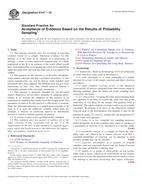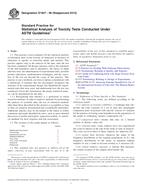Potrebujeme váš súhlas na využitie jednotlivých dát, aby sa vám okrem iného mohli ukazovať informácie týkajúce sa vašich záujmov. Súhlas udelíte kliknutím na tlačidlo „OK“.
ASTM E2093-12
Standard Guide for Optimizing, Controlling and Assessing Test Method Uncertainties from Multiple Workstations in the Same Laboratory Organization
Automaticky preložený názov:
Štandardné Guide pre optimalizáciu, Kontrola a vyhodnocovanie skúšobná metóda Neistoty z viacerých pracovných staníc v rovnakom laboratóriu organizácie
NORMA vydaná dňa 1.6.2012
Informácie o norme:
Označenie normy: ASTM E2093-12
Poznámka: NEPLATNÁ
Dátum vydania normy: 1.6.2012
Kód tovaru: NS-44265
Počet strán: 6
Približná hmotnosť: 18 g (0.04 libier)
Krajina: Americká technická norma
Kategória: Technické normy ASTM
Kategórie - podobné normy:
Anotácia textu normy ASTM E2093-12 :
Keywords:
accreditation practice, proficiency testing, workstation, ICS Number Code 03.120.30 (Application of statistical methods)
Doplňujúce informácie
| Significance and Use | ||||||||||||||||||
|
Many competent analytical laboratories comply with accepted quality system requirements. When using standard test methods, their test results on the same sample should agree with those from other similar laboratories within the reproducibility estimates index (R) published in the standard. Reproducibility estimates are generated as part of the interlaboratory studies (ILS), of the type described in Practice E1601. Competent laboratories participate in proficiency tests, such as those conducted in accordance with Practice E2027, to confirm that they perform consistently over time. In both ILS and proficiency testing protocols, it is generally assumed that only one work station is used to generate the data. Many laboratories have workloads, or logistical requirements, or both, that dictate the use of multiple work stations. Some have multiple stations in the same area (central laboratory format). Other stations are scattered throughout a facility (at-line laboratory format) and in some cases may even reside at different facilities. Often, analysis reports do not identify the workstation used for the testing, even if workstations differ in their testing uncertainties. Problems can arise if clients mistakenly attribute variation in report values to process rather than workstation variability. These problems can be minimized if the laboratory organization determines the overall uncertainty associated with results reported from multiple workstations and assesses the significance of the analytical uncertainty to the production process. This guide describes a protocol for efficiently optimizing and controlling variability in test results from different workstations used to perform the same test. It harmonizes calibration and control protocols, thereby providing the same level of measurement traceability and control to all workstations. It streamlines documentation and training requirements, thereby facilitating flexibility in personnel assignments. Finally, it offers an opportunity to claim traceability of proficiency test measurements to all included workstations, regardless on which workstation the proficiency test sample was tested. The potential benefits of utilizing this protocol increase with the number of workstations included in the laboratory organization. This guide can be used to identify and quantify benefits derived from corrective actions relating to under-performing workstations. It also provides means to track improved performance after improvements have been made. It is assumed that all who use this guide will have an established laboratory quality system. This system shall include the use of documented procedures, the application of statistical control of measurement processes, and participation in proficiency testing. ISO/IEC 17025 describes an excellent model for establishing this type of laboratory quality system. The general principles of this protocol can be adapted to other types of measurements, such as mechanical testing and on-line process control measurements, such as temperature and thickness gauging. In these areas, users may need to establish their own models for defining data quality objectives and proficiency testing may not be available or applicable. It is especially important that users of this guide take responsibility for ensuring the accuracy of the measurements made by the workstations to be operated under this protocol. In addition to the checks mentioned in 6.2.3, laboratories are encouraged to use other techniques, including, but not limited to, analyzing some materials by independent methods, either within the same laboratory or in collaboration with other equally competent laboratories. The risks associated with generating large volumes of data from carefully synchronized, but incorrectly calibrated multiple workstations are obvious and must be avoided. This guide is not intended to provide specific guidance on development of statements of measurement uncertainty such as those required by ISO/IEC 17025. However, the statistical calculations generated using this guide may provide a useful estimate of one Type A uncertainty component used in the calculation of an expanded uncertainty. This guide does not provide any guidance for determining the bias related to the use of multiple workstations in a laboratory organization. |
||||||||||||||||||
| 1. Scope | ||||||||||||||||||
|
1.1 This guide describes a protocol for optimizing, controlling, and reporting test method uncertainties from multiple workstations in the same laboratory organization. It does not apply when different test methods, dissimilar instruments, or different parts of the same laboratory organization function independently to validate or verify the accuracy of a specific analytical measurement. 1.2 This standard does not purport to address all of the safety concerns, if any, associated with its use. It is the responsibility of the user of this standard to establish appropriate safety and health practices and determine the applicability of regulatory limitations prior to use. |
||||||||||||||||||
| 2. Referenced Documents | ||||||||||||||||||
|
Podobné normy:
Historická
1.5.2014
Historická
1.8.2011
Historická
15.5.2010
Historická
1.10.2008
Historická
1.3.2013
Historická
1.3.2013
Odporúčame:
Aktualizácia zákonov
Chcete mať istotu o platnosti využívaných predpisov?
Ponúkame Vám riešenie, aby ste mohli používať stále platné (aktuálne) legislatívne predpisy
Chcete vedieť viac informácií ? Pozrite sa na túto stránku.



 ASTM D7915-14
ASTM D7915-14 ASTM E122-09e1
ASTM E122-09e1 ASTM E141-10
ASTM E141-10 ASTM E178-08
ASTM E178-08 ASTM E1847-96(2013)..
ASTM E1847-96(2013).. ASTM E1849-96(2013)..
ASTM E1849-96(2013)..
 Cookies
Cookies
